

Polyvinylpyrrolidone
| Price | USD1.00 |
| Packge | 1KG |
- Min. Order:1G
- Supply Ability:100KG
- Time:2019-07-06
Product Details
- Product NamePolyvinylpyrrolidone
- CAS No.9003-39-8
- EINECS No.1312995-182-4
- MFCH4
- MW16.04246
- InChIKeyFAAHNQAYWKTLFD-UHFFFAOYSA-N
- AppearancepowderWhite to yellow-white
- density 1,69 g/cm3
- Melting point >300 °C
- storage temp. 2-8°C
- Water Solubility Soluble in water.
- Boiling point 90-93 °C
AD68
| Product Name: | Polyvinylpyrrolidone |
| Synonyms: | K-30;POVIDONE;POP;POLYVINYLPYRROLIDONE K 25;POLYVINYLPYRROLIDONE K 30;POLYVINYLPYRROLIDONE K 90;POLYVINYLPYRROLIDONE K 60;POLYVINYLPYRROLIDONE-DIVERGAN RS |
| CAS: | 9003-39-8 |
| MF: | (C6H9NO)n |
| MW: | 0 |
| EINECS: | 1312995-182-4 |
| Product Categories: | Polymers;Food & Flavor Additives;Hydrophobic Polymers;Materials Science;Poly(vinylpyrrolidone);Polymer Science;Vinylpyridine and Vinypyrrolidone Polymers;API;medicinal new accessories;pharmaceutical intermediate and medicine grade |
| Mol File: | Mol File |
| Polyvinylpyrrolidone Chemical Properties |
| Melting point | ~165 °C (dec.)(lit.) |
| density | 1,69 g/cm3 |
| storage temp. | Store at RT. |
| solubility | H2O: soluble100mg/mL |
| form | powder |
| color | White to yellow-white |
| PH | 3.0-5.0 |
| Water Solubility | Soluble in water. |
| Sensitive | Hygroscopic |
| Merck | 14,7697 |
| Stability: | Stable. Incompatible with strong oxidizing agents. Light sensitive. Hygroscopic. |
| EPA Substance Registry System | 2-Pyrrolidinone, 1-ethenyl-, homopolymer(9003-39-8) |
| Safety Information |
| Safety Statements | 22-24/25 |
| WGK Germany | 1 |
| RTECS | TR8370000 |
| TSCA | Yes |
| HS Code | 39059990 |
| Hazardous Substances Data | 9003-39-8(Hazardous Substances Data) |
| Polyvinylpyrrolidone Usage And Synthesis |
| Vinylpyrrolidone polymer | Polyvinylpyrrolidone is abbreviated as PVP, and is the polymer of vinylpyrrolidone. According to the different degree of polymerization, it is further classified into soluble PVP and insoluble PVPP (polyvinyl polypyrrolidone). Molecular weight of the soluble PVP is 8,000 to 10,000.The soluble PVP can be used as a precipitating agent which can be settle down through its action with polyphenols. Using this method, it is easily to have residual PVP in the alcohol. Due to the savings effect of PVP inside the human body, the World Health Organization doesn’t recommend to apply this substance. In recent years, the use of soluble PVP has been rare. Insoluble PVPP system had began to be used in the beer industry since the early 1960s. It has a relative molecule weight greater than the relative mass greater than 700,000. It is a insoluble polymer derived from the further cross-linking and polymerization of PVP and can be used as an adsorbent of polyphenols with a good efficacy. 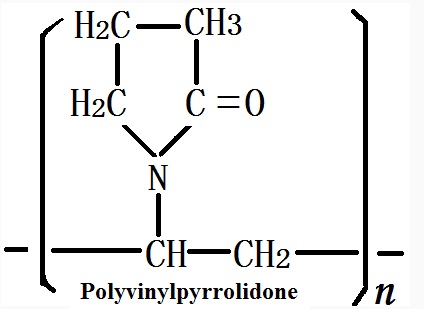 The molecular formula of Polyvinylpyrrolidone Polyvinylpyrrolidone PVP is one of the three major pharmaceutical new excipients and can be used as the co-solvent of tablets, granules, and injection, as the glidant of capsules, as the dispersant agent of liquid preparations and the colorant, as the stabilizer of enzyme and heat sensitive drug, as the co-precipitating agent of poorly soluble drugs, and as the detoxicant of ophthalmic drugs and lubricants. It is industrially used as expanded polystyrene additive, as the gelling agents for suspension polymerization, stabilizer, and fiber treating agents, paper processing aids, adhesives, and thickening agents. Polyvinylpyrrolidone PVP and its copolymers CAP is an important raw material of cosmetics, mainly used for hair retaining agent. The film it formed in the hair is elastic and shiny, and has excellent carding property as well as being free of dust. Adopting different category of resin can meet various kinds of relative humidity climatic conditions. Therefore, it is an indispensable raw material in styling hair cream, hair gel, and mousse. It can also be used for the cosmetics of skin moisturizing agents and the dispersants for grease based hair dying, also as foam stabilizers, and can improve the consistency of the shampoo. Insoluble PVP is the stabilizer of beer and juice which can improve its transparency, color, and flavor. |
| Water-soluble polyamides | Polyvinyl pyrrolidone (PVP) is a water soluble polyamide. Commercially available PVP is divided into four viscosity grades according to its press K value (Fikentscher K value): K-15, K-30, K-60, K-90, with the average molecular weight being 10,000, 40000,160000, and 360000, respectively. K value or molecular weight is an important factor which decides the various properties of PVP. Polyvinyl pyrrolidone (PVP) is dissolved in water, chlorinated solvents, alcohol, amine, nitro-paraffin and low molecular weight fatty acids, and is mutually soluble with most inorganic salts and a variety of resin; insoluble in acetone and ether. PVP used for the matrix of dropping pill matrix is odorless, tasteless, white to pale yellow waxy solid with the relative density being 1.062, and its 5% aqueous solution pH being 3 to 7. PVP is hygroscopic and of good thermal stability, and can be dissolved in various kinds of organic solvents, and has high melting point. Adding certain natural or synthetic polymers or organic compounds can effectively adjust the PVP’s hygroscopicity and softness. PVP is not prone to have chemical reaction. Under normal storage conditions, dry PVP is quite stable. PVP has excellent physical inertia and biocompatibility and has not stimulation to skin, eyes no stimulation with no allergic reactions and being non-toxic. Because of the hydrogen bonding or complexation effect, PVP’s viscosity is increased and this further inhibits the formation and growth of crystallized nuclei of drugs, making the drug being in the amorphous state. The dropping pill whose matrix is PVP can enhance the dissolution and bioavailability of poorly soluble drugs. In general, the greater the PVP amount, the higher dissolution and solubility of drug in the medium. Susana et al have studied the dissolution of the PVP solid dispersant of the slightly soluble drug albendazole. The increased amount of PVP (k30) can increase the dissolution rate and efficiency of drug inside the solid dispersant. Teresa et al have studied the dissolution of the poorly soluble drugs, flunarizine in PVP solid dispersant and obtained similar conclusion. PVP also found that the higher the content, the more significant increase in dissolution. IR has showed that flunarizine and PVP has no chemical reaction except in some cases that a best dissolution efficacy is obtained only in certain ratio between some drugs with the PVP. Tantishaiyakul et al has found that: when the ratio of piroxicam: PVP is 1:5 and 1:6, the dissolution of the solid dispersant is the largest with a 40 times as high as that of single drug within 5min. PVP can also be dissolved in another molten dropping pill matrix, such as polyethylene glycol (PEG), polyoxyethylene monostearate (S-40), poloxamer and stearyl acid, glyceryl monostearate, etc for making complex matrix. The above information is edited by the Chemicalbook of Dai Xiongfeng. |
| Physical and chemical properties | Commonly used PVP level in the cosmetic industry is K-30. Commercialized PVP is white and free flowing powder or solids with its content in the mass fraction of 20%, 30%, 45% and 50% aqueous solution. PVP is soluble in water and is hygroscopic with a moisture equilibrium being 1/3 of the relative humidity of the environment. Similar as the protein hydration action, each monomer associates with 0.5mol water.Chart 1 and Chart 2 lists the reference quality standard of various types of polyvinylpyrrolidone PVP: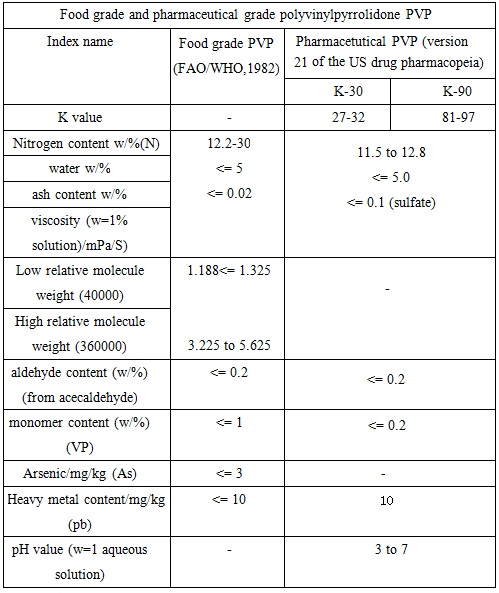 Chart 1: Food grade and pharmaceutical grade polyvinylpyrrolidone PVP 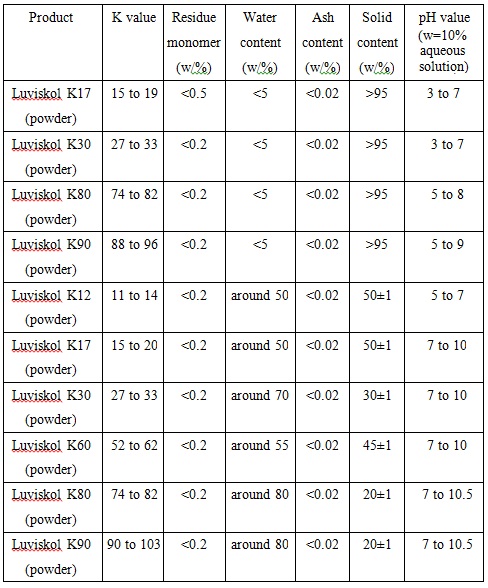 Chart 2: Cosmetics and industrial polyvinylpyrrolidone PVP (Luvikol K, BASF) PVP is not easy to have chemical reaction. When stored at normal conditions, dry PVP is quite stable. Solution undergone mildew treatment is also stable. When heated in air to 150 °C or mixed with ammonium persulfate to heat at 90 °C for 30min, PVP will be exchanged to become a water-insoluble compound. In the presence of azo compound or a dichromate oxidizing agent, light will cause PVP solution to become gel. The co-heating of PVP solution with strong base (such as sodium silicate or trisodium phosphate) will generate precipitation. Many different compounds can generate complexes with PVP. For example, the complexes of PVP and iodine is very stable and have a good bactericidal effect and can reduce its toxicity; Adding the copolymers of the polyacrylic acid, tannic acid or methyl vinyl ether and maleic acid to the aqueous solution of PVP will generate insoluble complexes which are insoluble in water, alcohols and ketones. But when being treated with base for neutralize the poly-acid can reverse the reaction; complexation between PVP and toxins, drugs and toxic chemicals can reduce their toxicity; some kinds of dyes can also form a strong complex with PVP, which is the basis for using PVP as a dye bleaching agent. |
| The use of polyvinylpyrrolidone | In the early 1950s, older, with shellac and oil-based hairspray had been rapidly replaced by PVP sprays which are still widely used until now. It can form wet, transparent film on the hair which is shiny and has good lubrication effect. PVP has good compatibility with a variety of good propellant and also has corrosion resistance. It is widely used in hair styling, as the film former in combing products, as the creatinine and stabilizer of skin care lotions and creams, as the base stock material for eye and facial cosmetics and lipstick base, and also as hair dye dispersants and shampoo foam stabilizer. PVP has detoxification effect and can reduce the irritation effects of other preparation on the skin and eyes. It is also used as toothpaste detergents, gelling agents and antidotes. The main drawback of PVP is its sensitivity to moisture. However, this issue can be tackled by using its vinyl acetate copolymer in order to mitigate the effects of moisture and humidity. In addition, PVP also has wide application in the pharmaceutical, beverage and textile industries. |
| Rheological properties of solutions | Water and methanol is the preferred solvent of PVP. pH value has little effect on the viscosity of the aqueous solution of PVP, for example, at 25 °C, pH range: 0.1~10, aqueous solution of PVP K-30 with a mass fraction of 5% concentration has a viscosity of 2.3~2.4mPa • s; in concentrated hydrochloric acid, this is 4.96mPa • s. Effect of temperature on the viscosity of the PVP aqueous solution is also relatively not obvious. Un-cross-linked PVP solution is not particularly thixotropic unless under very high concentration and display a short relaxation time. The chart 3 below lists the viscosity of PVP K-30 in a variety of solvents.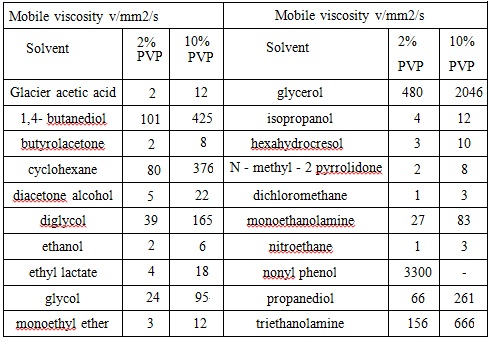 Chart 3: Viscosity of PVP K-30 in various organic solvents (w %) (At room temperature) Reference: Edited by Binyi Qiu, “Compendium of cosmetic chemistry and technology” Volume 1 Beijing: China Light Industry Press, 1997. |
| Compatibility | Polyvinylpyrrolidone is mainly used as pharmaceutical excipient, blood compatibilizer, cosmetics thickening agents, latex stabilizers, and clarifying agent of beer brewing. Not matter whether in solution or in the form of film, PVP always has a high degree of compatibility. It has good compatibility with various kinds of inorganic salt solution, many natural and synthetic resins and other chemical compatibility. Examples of their compatibility are seen at chart 4 and Figure 5. 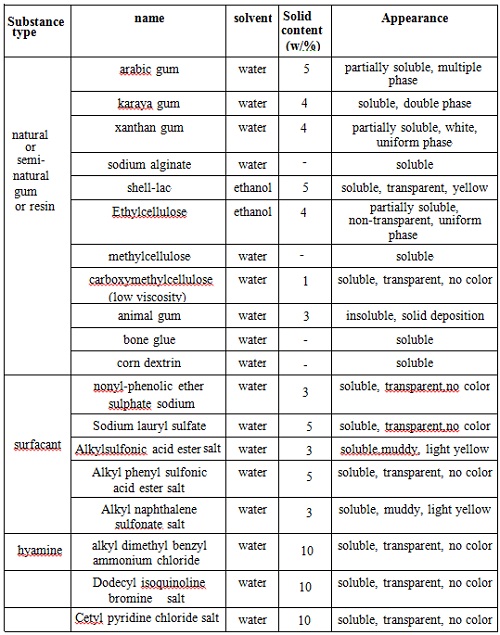 Chart 4: The compatibility of PVP and some other substances in water and ethanol 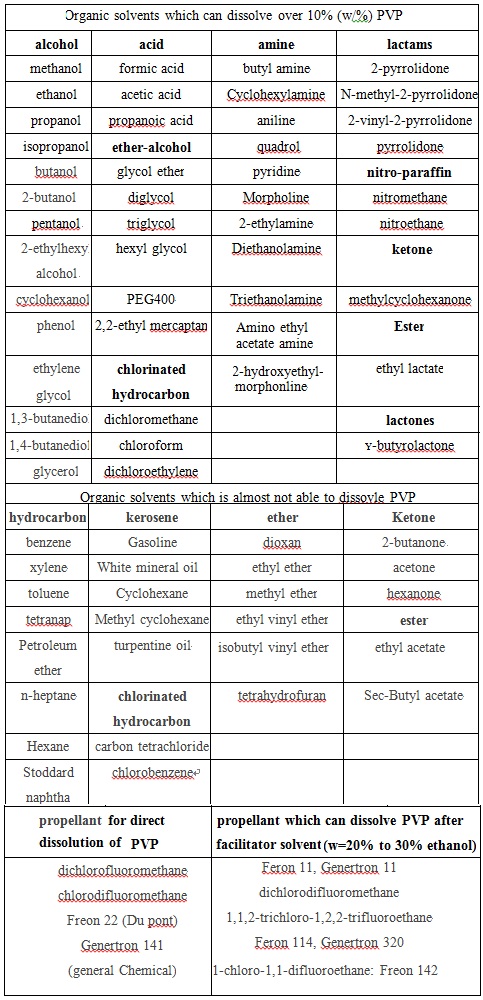 Chart 5: The solubility and compatibility of PVP in various solvents |
| Safety | PVP is physiologically inert. Acute oral toxicity of PVP: LD50 > 100g/kg. It does not irritate the skin or eyes, do not cause skin allergies. A large number of long-term toxicology studies have confirmed that polyvinylpyrrolidone (PVP) can tolerate intraperitoneal, intramuscular, intravenous administration and parenteral applications. Subacute and chronic toxicity result was negative. |
| Identification test | Solubility: soluble in water, ethanol and chloroform and insoluble in ether. This is measured by the OT-42 method. Dichromate precipitation test: in 5 mL of2% sample solution, add 5 mL dilute hydrochloric acid solution (TS-117), further add 5 mL of water plus 2 mL of 10% potassium dichromate solution and 2ml. This should form an orange precipitate. Take 75 mg of cobalt nitrate and 300 mg of ammonium thiocyanate for being dissolved in 2ml of water; add 5 mL of 2% aqueous sample solution; after the mixing, add dilute hydrochloric acid test solution (TS-117) for acidification. This should form light blue precipitate. Take 5 mL of 2% sample solution; add 1 mL of 25% hydrochloric acid, 5 mL of 5% barium chloride and 1 mL 5% molybdenum tungsten phosphoric acid solution. This should generate a lot of white precipitate which gradually turns blue in the sunlight. The pH value of 5% sample solution should be 3.0 to 3.7. This is measured by conventional means. Adding a few drops of iodine test solution (TS-124) to 5 mL of 0.5% sample solution should produce a deep red color. Take 1 g of sample, add water to 10 ml as a suspension, add 0.1 mL of iodine test solution (TS-124), after mixing by shaking for 30s, iodine test solution should fade (to distinguish polyvinylpyrrolidone due to that polyvinylpyrrolidone can form red color). Add 1 mL of starch test solution (TS-235), after shaking and mixing, there should be no blue color formed. to produce blue. |
| Content Analysis | Estimated from the nitrogen content according to the following index of quality. |
| Toxicity | ADI 0~50 (FAO/WHO, 2001) LD50> 100g/kg (rat, oral). ADI does not make special provision (FAO/WHO, 2001). It is safe for food (FDA, §121.1110, §173.50, 2000). LD50:12g/kg (mice, abdominal injection). |
| Limited use | GB 2760-1996: beer GMP. |
| Chemical Properties | It is the cross-linked homopolymer of pure vinylpyrrolidone. It is hygroscopic and free-flowing white or off-white powder. It has a slight foul smell. It is insoluble in common solvents such as water, ethanol and ether. So its molecule weight range can’t be measured. However, PVP has ability to form complex with various kinds of substances (such as “Hu” class substance which can lead to the discoloration of a variety of wines and beverages discoloration). Also it is easily to be removed after filtration because of its insolubility. |
| Uses | Clarifying agent; pigment stabilizer; colloidal stabilizer; It is mainly used for beer clarifying and quality stabilizing (reference amount 8~20g/100L, maintained for 24h and remove it by filtration), and can also be applied in combination with enzymes (protease) and protein adsorbents. It is also used to clarify the wine and as a stabilizer to prevent discoloration (reference amount 24~72g/100L). Clarifying agents; stabilizers; thickeners agent; tablet fillers; dispersants; PVP of molecular weight 360,000 are often used as the clarifying agent of beer, vinegar, and grape wine. Used as the fixing liquid for gas chromatography. It is used as a colloidal stabilizer and clarifying agent for beer clarification. Apply proper amount according the demands of production. It can be used for pharmacy, aquaculture, and livestock disinfectant for the sterilization of the skin and mucous. PolyFilterTM molecule has an amide bond for absorbing the hydroxyl groups located in polyphenol molecule to form hydrogen bonds, and therefore, can be used as the stabilizer of beer, fruit wine/grape wine, and drinking wine to extend their shelf life and improve the transparency, color and taste. The products have two specifications: disposable type and regeneration type. Disposable products are suitable for application by SMEs; renewable products demand the purchase of special filtration equipment; but since it is recyclable, it is suitable for large breweries for recycle application. In daily cosmetics, PVP and its copolymer has good dispersion property and filming property, and thus being able to be used as a setting lotion, hair spray and styling mousse, as opacifiers for hair care agents, as the stabilizer of shampoo foam, as wave styling agent and as the dispersants and affinity agents in hair dye. Adding PVP to cream, sunscreen, and hair removal agent can enhance wetting and lubricating effect. Taking advantage of the excellent properties of PVP such as surface activity, film-forming and non-irritating to the skin, no allergic reactions, etc., has broad prospects in its application in hair care and skin care products. |
| Production method | Its crude product comes from the polymerization of vinylpyrrolidone under basic catalyst or the existence of N, N'-divinyl amidine and further cross-inking reaction. Then use water, 5% acetic acid and 50% ethanol for reflux to until extract ≤50mg/kg (for over 3h). The 30% to 60% aqueous solution of the purified 1-vinyl-2-pyrrolidone, in the presence of ammonia or amines and also with hydrogen peroxide as the catalyst, has cross-linking and homo-polymerization reaction at a temperature of 50 °C and subject to further purification to obtain the final product. |
| Chemical Properties | white powder |
| Uses | suitable for gene delivery |
| Definition | ChEBI: A vinyl polymer composed of repeating -CH2-CR- units where R is a 2-oxopyrrolidin-1-yl group. |
| General Description | White powder. Compatible with a wide range of hydrophilic and hydrophobic resins. |
| Air & Water Reactions | Hygroscopic. Water soluble. |
| Reactivity Profile | Polyvinylpyrrolidone is a polymeric material and probably has low reactivity. Polyvinylpyrrolidone reacts as a weak base. |
| Health Hazard | SYMPTOMS: Polyvinylpyrrolidone may cause interstitial fibrosis in the lungs. Lesions regress when patient is no longer being exposed to the compound. |
| Fire Hazard | Flash point data for Polyvinylpyrrolidone are not available, but Polyvinylpyrrolidone is probably non-flammable. |
Company Profile Introduction
Henan CoreyChem Co., Ltd, based on the original Zhengzhou Cote Chemical Research Institute, be brave in absorbing highly educated talents & overseas returnees; actively responded to Zhengzhou City High-tech Zone Government’s Special Care Policy, reorganized and founded in National University of Science and Technology Park, which is a high-tech, stock enterprise of high-end chemical Custom synthesis;The park was created by the People's Government of Henan Province, and proved by Ministry of Education and the National Science & Technology, taking the construction mode of "many college a park, and common development", mainly depends on Zhengzhou University and Henan University’s scientific research and talent advantage to set up Universities, scientific research institute and enterprise scientific research achievements transformation platform, to make high-tech enterprises incubate, is the new high-tech talent gathering base, high and new technology industry enterprise radiation base, colleges and universities technological innovation base.
Henan Coreychem Co., Ltd, facing global High-tech pharmaceutical raw materials, high complex new type intermediates, fine chemicals custom synthesis, scale-up production and Rare chemicals trade. Corey have well-equipped machine, strong technical force and considerate marketing team service. We also have rich experience advantage in basic research, small scale process development, scale-up, industrial technology development & production and cost control.
Recommended supplier
-
VIP1年
- ARRAKIS INDUSTRIES LLP
- POLYVINYL PYRROLIDONE (K-90) 99%
- Inquiry
- 2024-11-05
-
VIP1年
- Alcedo Pharmachem Private Limited
- 9003-39-8 / 25249-54-1 Povidone 98%
- Inquiry
- 2024-03-11
-
VIP1年
- Adani Pharmachem Pvt Ltd
- 9003-39-8 / 25249-54-1 99%
- Inquiry
- 2024-02-17
-
VIP1年
- Prachin Chemical
- 9003-39-8 / 25249-54-1 Povidone 98%
- Inquiry
- 2024-02-05
-
VIP1年
- Krishna Solvechem Ltd.
- Povidone 9003-39-8 / 25249-54-1 98%
- Inquiry
- 2024-01-31
-
VIP1年
- Hemarsh Technologies
- Povidone 98%
- Inquiry
- 2024-01-23
-
VIP1年
- Glide Chem Pvt. Ltd
- 9003-39-8 / 25249-54-1 98%
- Inquiry
- 2024-01-23
-
VIP1年
- Dhanraj Rathod
- 9003-39-8 Povidone K30 99%
- Inquiry
- 2023-12-16
-
VIP1年
- ARRAKIS INDUSTRIES LLP
- 9003-39-8 POLYVINYL PYRROLIDONE (K-25) 99%
- Inquiry
- 2024-11-05
-
VIP1年
- ARRAKIS INDUSTRIES LLP
- POLYVINYL PYRROLIDONE (K-30) 99%
- Inquiry
- 2024-11-05
- Since:2014-12-17
- Address: No.967,15th Floor,Unit 7, Building 1, No.70 of DianChang Road, High-tech Development Zone, Zhengzho
INQUIRY
